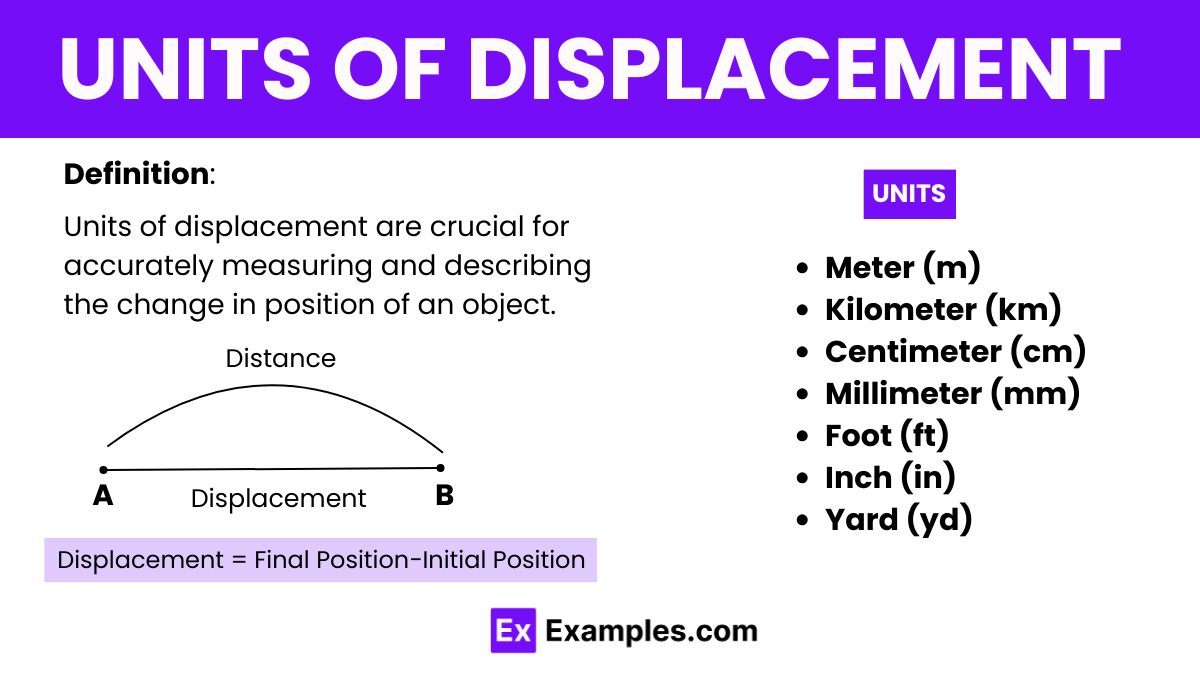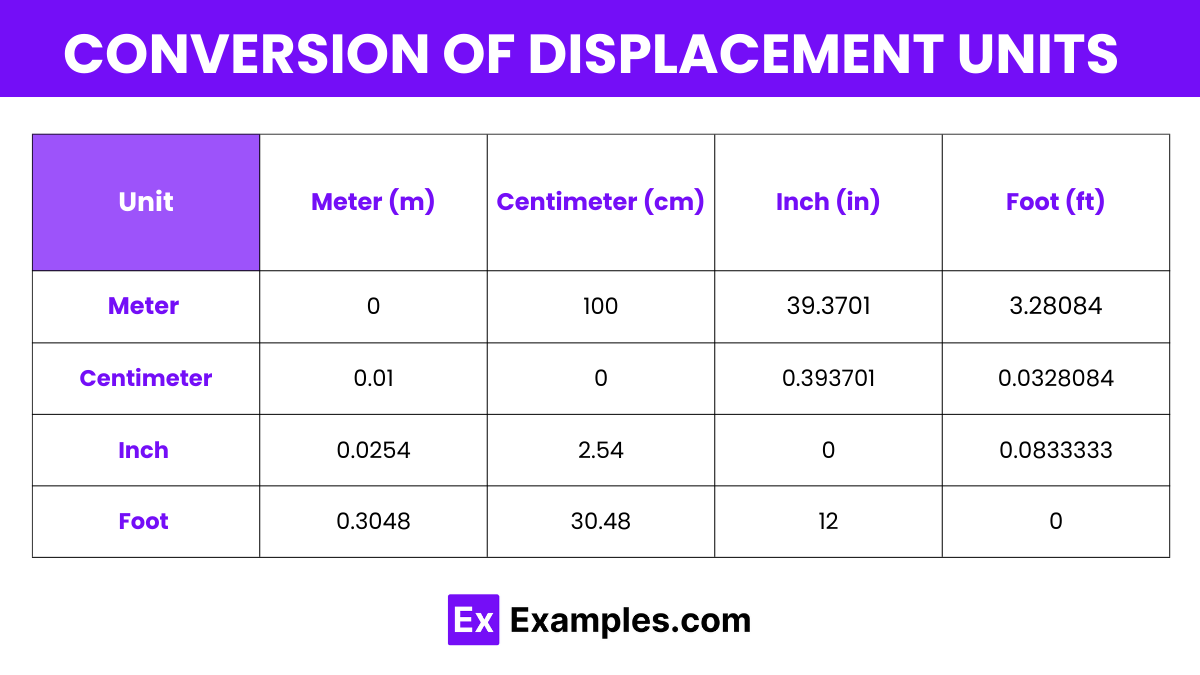What is the SI unit of displacement?
Meter
Second
Kilogram
Ampere

Displacement, a vector quantity that refers to the change in position of an object, is a fundamental concept in physics, particularly in the study of motion. Understanding the units used to measure displacement is essential for precisely describing and analyzing motion.
The meter (m) is the standard International System of Units (SI) unit for measuring displacement. It effectively quantifies the straight-line distance from an object’s starting point to its final position. Widely adopted across scientific disciplines, the meter is essential for accurately documenting and analyzing linear motion in physics, engineering, and everyday applications.
In the Centimeter –Gram–Second(CGS) system, the centimeter (cm) serves as the primary unit of displacement. This unit measures the distance an object travels, effectively capturing both minor and significant movements within smaller scales of observation.
The formula for displacement is given by:
This equation calculates the straight-line distance from the starting point to the ending point of an object’s path.
| Unit | Symbol |
|---|---|
| Meter | m |
| Centimeter | cm |
| Kilometer | km |
| Inch | in |
| Foot | ft |
| Yard | yd |
| Mile | mi |
Here’s the detailed format for different units of displacement, similar to the format used for units of energy:
The meter is the SI unit of displacement and measures the distance traveled by an object in space. It is widely used globally in science, engineering, and daily life to quantify linear travel.
A centimeter is a common unit of displacement for smaller distances, especially used in fields that require precise spatial measurements, such as architecture and engineering.
Kilometers measure longer distances and are commonly used to express geographical distances between locations or in tracking athletic performances in long-distance events.
The inch is a unit of displacement commonly used in the United States for various applications, including manufacturing and construction.
A foot is an imperial unit used primarily in the United States and the United Kingdom for a variety of everyday measurements, including height and short travel distances.
Yards are used in several contexts, such as in golf for measuring distances to the green and in fabric stores for selling cloth by length.
Miles are used primarily in the United States and the United Kingdom to measure long distances, such as in road signage and car odometer readings.

| Displacement Unit | Meter (m) | Centimeter (cm) | Inch (in) | Foot (ft) |
|---|---|---|---|---|
| Meter (m) | 0 | 100 | 39.3701 | 3.28084 |
| Centimeter (cm) | 0.01 | 0 | 0.393701 | 0.0328084 |
| Inch (in) | 0.0254 | 2.54 | 0 | 0.0833333 |
| Foot (ft) | 0.3048 | 30.48 | 12 | 0 |
The SI unit of displacement current is the ampere (A), just like the unit for conventional electric current.
Displacement is not always zero; it depends on the initial and final positions.
Yes, displacement can be negative, indicating the final position is in the opposite direction to the defined positive direction.

Displacement, a vector quantity that refers to the change in position of an object, is a fundamental concept in physics, particularly in the study of motion. Understanding the units used to measure displacement is essential for precisely describing and analyzing motion.
Units of displacement are crucial for accurately measuring and describing the change in position of an object. Understanding these units enhances our ability to document and analyze motion across various scientific and engineering disciplines.
meter (m)
The meter (m) is the standard International System of Units (SI) unit for measuring displacement. It effectively quantifies the straight-line distance from an object’s starting point to its final position. Widely adopted across scientific disciplines, the meter is essential for accurately documenting and analyzing linear motion in physics, engineering, and everyday applications.
centimeter (cm)
In the Centimeter –Gram–Second(CGS) system, the centimeter (cm) serves as the primary unit of displacement. This unit measures the distance an object travels, effectively capturing both minor and significant movements within smaller scales of observation.
The formula for displacement is given by:
Displacement = Final Position−Initial Position
This equation calculates the straight-line distance from the starting point to the ending point of an object’s path.
Unit | Symbol |
|---|---|
Meter | m |
Centimeter | cm |
Kilometer | km |
Inch | in |
Foot | ft |
Yard | yd |
Mile | mi |
Here’s the detailed format for different units of displacement, similar to the format used for units of energy:
1m
The meter is the SI unit of displacement and measures the distance traveled by an object in space. It is widely used globally in science, engineering, and daily life to quantify linear travel.
1 cm = 0.01 m
A centimeter is a common unit of displacement for smaller distances, especially used in fields that require precise spatial measurements, such as architecture and engineering.
1 km = 1000 m
Kilometers measure longer distances and are commonly used to express geographical distances between locations or in tracking athletic performances in long-distance events.
1 in = 0.0254 m
The inch is a unit of displacement commonly used in the United States for various applications, including manufacturing and construction.
1 ft = 0.3048 m
A foot is an imperial unit used primarily in the United States and the United Kingdom for a variety of everyday measurements, including height and short travel distances.
1 yd = 3 ft = 0.9144 m
Yards are used in several contexts, such as in golf for measuring distances to the green and in fabric stores for selling cloth by length.
1 mi = 5280 ft = 1609.34 m
Miles are used primarily in the United States and the United Kingdom to measure long distances, such as in road signage and car odometer readings.
Displacement Unit | Meter (m) | Centimeter (cm) | Inch (in) | Foot (ft) |
|---|---|---|---|---|
Meter (m) | 0 | 100 | 39.3701 | 3.28084 |
Centimeter (cm) | 0.01 | 0 | 0.393701 | 0.0328084 |
Inch (in) | 0.0254 | 2.54 | 0 | 0.0833333 |
Foot (ft) | 0.3048 | 30.48 | 12 | 0 |
Conversion: 1 meter = 100 centimeters.
Example: To convert 5 meters to centimeters:
5 m × 100 = 500 cm
Conversion: 1 meter = 3.28084 feet.
Example: To convert 3 meters to feet:
3 m × 3.28084 = 9.84252 ft
Conversion: 1 meter = 39.3701 inches.
Example: To convert 2 meters to inches:
2 m × 39.3701 = 78.7402 in
Conversion: 1 centimeter = 0.01 meters.
Example: To convert 250 centimeters to meters:
250 cm × 0.01 = 2.5 m
Conversion: 1 centimeter = 0.0328084 feet.
Example: To convert 100 centimeters to feet:
100 cm × 0.0328084 = 3.28084 ft
Conversion: 1 centimeter = 0.393701 inches.
Example: To convert 150 centimeters to inches:
150 cm × 0.393701 = 59.05515 in
Conversion: 1 foot = 0.3048 meters.
Example: To convert 10 feet to meters:
10 ft × 0.3048 = 3.048 m
Conversion: 1 foot = 30.48 centimeters.
Example: To convert 6 feet to centimeters:
6 ft × 30.48 = 182.88 cm
Conversion: 1 foot = 12 inches.
Example: To convert 4 feet to inches:
4 ft × 12 = 48 in
Conversion: 1 inch = 0.0254 meters.
Example: To convert 20 inches to meters:
20 in × 0.0254 = 0.508 m
Conversion: 1 inch = 2.54 centimeters.
Example: To convert 50 inches to centimeters:
50 in × 2.54 = 127 cm
Conversion: 1 inch = 0.0833333 feet.
Example: To convert 36 inches to feet:
36 in × 0.0833333 = 3 feet
The SI unit of displacement current is the ampere (A), just like the unit for conventional electric current.
Displacement is not always zero; it depends on the initial and final positions.
Yes, displacement can be negative, indicating the final position is in the opposite direction to the defined positive direction.
Text prompt
Add Tone
10 Examples of Public speaking
20 Examples of Gas lighting
What is the SI unit of displacement?
Meter
Second
Kilogram
Ampere
Which of the following is a non-SI unit of displacement?
Meter
Kilometer
Mile
Newton
How is displacement different from distance?
Displacement is scalar; distance is vector
Displacement has direction; distance does not
Displacement is always positive; distance can be negative
Displacement is measured in seconds; distance in meters
If an object moves from position A to position B, what does its displacement represent?
The total path length covered
The straight-line distance between A and B
The time taken to move from A to B
The speed of the object
In which units can displacement be expressed in the CGS (centimeter-gram-second) system?
Centimer
Meter
Kilometer
Millimeter
Convert 500 meters to kilometers.
0.05 km
5 km
0.5 km
50 km
What is the unit of displacement in the MKS (meter-kilogram-second) system?
Meter
Kilogram
Second
Mile
Which unit would be most appropriate to measure the displacement of a car on a road trip?
Centimeter
Kilometer
Meter
Millimeter
How does displacement differ from distance traveled in a circular path?
Displacement is zero; distance is the circumference
Displacement is the circumference; distance is zero
Displacement and distance are the same
Displacement is half the circumference; distance is the radius
What is the unit of displacement in the British Imperial system?
Meter
Yard
Inch
Foot
Before you leave, take our quick quiz to enhance your learning!

